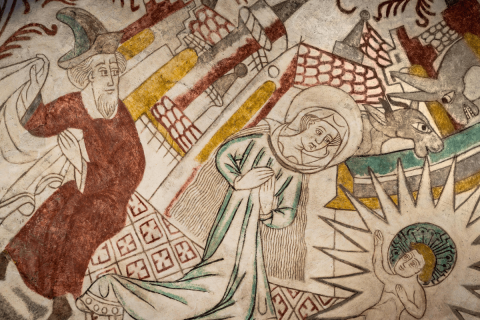
The story of Jesus' birth has some well-known moments: "no room in the inn," shepherds keeping watch, angels bearing good tidings, Baby Jesus in the manger, and, lo, a star! But the Christmas story also says a lot about God's heart for social justice. Read on!
December reflections on scripture from the Revised Common Lectionary, Cycle A.
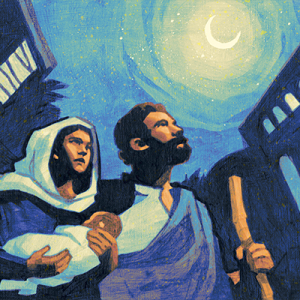
IN ADVENT, I remember and am grateful for all the prophets who show us the way of the divine. They invite us to remember and live out God’s command to love each other as much as we love God. I call to mind biblical scholar Walter Brueggemann, who passed away this year. He was a mentor, teacher, and colleague to many, including me. He taught us to prophetically reimagine a world where we challenge dominant and oppressive ideologies while compassionately re-envisioning a more just world. His magnanimous presence and prophetic words will be missed.
I also remember the young—led by Mary, the mother of Jesus—who invite us to be prophetic during adversity. With the guidance of Osvaldo D. Vena, we are invited to dream dreams in the joyous playground of God. Grounded in the abundance of God in our lives, I celebrate with Son Kyung Min’s praise song “Grace,” which I highly recommend for personal devotion and corporate worship services. The music grounds me in my faith and prompts me to remember how surrounded I am by God’s love.
As we approach the season of Christmas, let us pay close attention to the needs of our neighbors, especially our international students and immigrant neighbors. Every moment provides an opportunity for us to share the gift of the redemptive love of God.
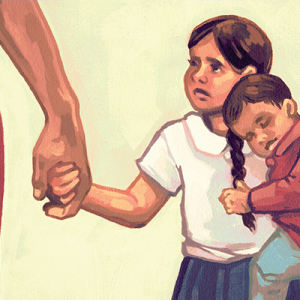
THERE IS MUCH anticipation in the air. During Advent, we eagerly await the Christ child among us and all the blessings and transformations this infant brings. Our readings during this season remind us of the Christ child’s vision for our world — and of God’s power to upend existing political orders. This is the child whose mother proclaims that he will “cast down the mighty,” “lift up the lowly,” and change the course of history for God’s people. We welcome the arrival of new life in Christ, imbued with hope and reminders that life is never fully defeated by empire’s death-dealing designs.
But this Christ child comes in many guises. This child appears as an unhoused person, a racial other, an incarcerated person, a foreigner. Will we receive every child of God as we receive the Christ child and honor their hopes and full potential? Will we give to all of God’s children the gifts of our time, energy, joy, and relationship so that our communities become hospitable places for the Christ child and every child?
December reflections on scripture from the Revised Common Lectionary, Cycle B

“THE CONTEMPLATIVE ON her knees well knows the messy entanglement of sexual desire and desire for God,” writes theologian Sarah Coakley. If she’s right, then attending to what arouses us sensually can teach us something about how God lures us through our longing and, even, how we can attract God’s intimacy. This month, we’re exploring how queer theology can invigorate (dare I say, stimulate?) the anticipation we build throughout Advent. This approach may seem blasphemous to some who aren’t familiar with a queer-affirming lens ... and perhaps uncomfortable to some who are. Many of us are steeped in Christian body-denying theologies and moralities. We are uncomfortable meeting God in ways that are playful, erotic, unnerving, and always cognizant of power dynamics (though scripture is steeped with such sexual innuendo). Queer theology starts from (rather than argues for) not just queer affirmation, but queer celebration. It can expose the erotic dimensions of our sacred stories to reveal God’s wild and promiscuous desire for all creation.
December is a season for sending Christmas cards depicting the Holy Family — perhaps the most heteronormative image in the church year: A mom and dad stare lovingly at their beautiful baby. This static image can obscure the mess of desire, power, submission, and surprising gender fluidity required to incarnate this Holy Child. What moves in us as we ponder the design of different Christmas images that don’t shy away from this beautiful mess? What images help us face the wonder and terror of what it feels like to be undone and remade by God’s overcoming?
December reflections on the Revised Common Lectionary, Cycle C.

ON SUFJAN STEVENS' 2012 Christmas album, Silver & Gold, he includes “Ah Holy Jesus,” a hymn about Christ’s crucifixion. Stevens sings: “For me, kind Jesus, was thine incarnation / thy mortal sorrow, and thy life’s oblation / thy death of anguish and thy bitter passion / for my salvation.” The cross on Golgotha casts a long shadow toward Bethlehem. When the child in the manger grows into adulthood, our world kills him. The story of the incarnation is the story of crucifixion.
For Stevens to sing such a hymn during this season reminds us that Jesus was born into an anguished world—an anguish that took hold in his life, an agony unto death. “The whole life of Jesus comes under the heading ‘suffered,’” theologian Karl Barth commented. “For the evangelists Luke and Matthew, the childhood of Jesus, his birth in the stable of Bethlehem, were already under the sign of suffering,” Barth continued. “The entire life of Jesus is lived ... in the shadow of the cross.”
Jesus didn’t offer salvation as an escape plan from our life’s travails but as a commitment to heal us from the habits of sin, the violence that cuts through each of us and the world. Christmas Day doesn’t redeem our wounded world in an instant—as if the old order vanishes with the newborn’s first cry. Instead, Jesus undergoes a human life and entrusts our lives to the Holy Spirit’s care.
Salvation is a salve, the soothing presence of the Spirit. This same Comforter took care of Mary at Jesus’ birth and ministered to him during his passion. “For me, kind Jesus, was thine incarnation ... and thy life’s oblation.”
December reflections on the Revised Common Lectionary, Cycle A

A FEW YEARS ago, I set out to knit a baby blanket as an Advent prayer practice. Knitting is incredibly meditative and allows me to pray with focus and clarity. Knitting a baby blanket seems appropriate as the church awaits the arrival of the “newborn king.” I wish I could say I finished the blanket in time for Christmas. I did not. However, even that seems appropriate, as so much remains unresolved for Jesus’ community at his birth. Their political occupation continued, and even Jesus’ birth story reflects the impositions placed upon his family by the Roman Empire. God’s inbreaking happens under serious duress — but it happens nonetheless.
My favorite lines from the poem “Christmas is Waiting to be Born” by Howard Thurman are: “Where fear companions each day’s life, / And Perfect Love seems long delayed. / CHRISTMAS IS WAITING TO BE BORN: / In you, in me, in all [hu]mankind.”
Thurman reminds us that God was born into our sorrow and among those who are brokenhearted and struggling. That truth is so important to hold on to as we process years of our own collective trauma. No matter how unresolved things are, Christmas is born in us, too! In December we continue our journey through Advent and arrive at Christmas. We might not have received what we’re waiting for by that time, and very little may make sense. Yet, because of who God is, we open our hearts to the improbable, trusting that we won’t be put to shame.
December reflections on the Revised Common Lectionary, Cycle B.
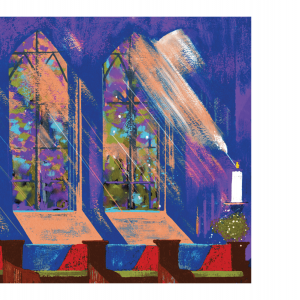
WE HAVE COME through a turbulent year in which health concerns, weather concerns, social unrest concerns, and more have been at the center of our thoughts. From the first time we heard “COVID-19” to the last storm of hurricane season to the deaths of many significant cultural icons in the U.S., we have found ourselves reeling—or at least I have, and so have many people I know.
Advent and the beginning of the Christmas season give us an opportunity to recalibrate and take a breath. We are into the new Christian calendar, and for Christians that reality should mean something. Expectation, hope, joy, and peace are just some of the Christian ways of leaning into life. Advent allows us to flex those faith muscles. And we need them, because, as the texts for the first days of Christmastide notes, the struggle under which we live does not dissipate. We live our Christian faith most often amid social crises. “Calm” and “peace” are aspirational at best. The reflections for this month try to make sense of how we flex those muscles I mentioned earlier. How do we participate in God’s desire for us to live together in just, holy, equitable ways? How do we hold ourselves and each other accountable to building the commonwealth of God, in which we each play our part, great or small, so that all are made whole?
Reflections on the Revised Common Lectionary, Cycle A.

WE ARE LIVING in a moment of ruptured imagination brought on by the growing specter of deadly violence, which has triggered in many a crisis of faith. But these lectionary readings say to Christians, “Wait a minute, not so fast!” A promise-bearing deliverer has come to topple competing kingdoms and bring distress to wielders of death. Matthew’s message is, “Keep awake.” And the prayerful petitions of the psalms outline the marks of righteous governance: defending the poor, giving deliverance to the needy, and crushing the oppressor (Psalm 72:4).
Salvation comes in the form of a child and angels act as divine emissaries—quieting fear in one instance and stirring up disquiet in the hearts of others (Matthew 2). Were it not for an angel allaying Joseph’s fear about Jesus’ atypical paternity, life as a teenage single parent would have been Mary’s lot. Had an angel not appeared to Joseph in a dream urging him to flee to Egypt, or had a dream not disrupted the course of the Magi warning them to not return to Herod, the scriptural record would have unfolded very differently.
The promise of coming joy and peace reveals much more than incarnational presence. Jesus’ coming brings to our expectant minds the essential nature of a God who wields love and salvation. God always provides a way to secure such provisions. Angelic envoys, as Matthew narrates, stand ready to do God’s bidding.
Reflections on the Revised Common Lectionary, Cycle C.

ONE OF THE BEDROCK assertions of the Christian faith is that the kingdom of God is coming.
Jesus announced God’s reign, and embodied it, and brought it among us, but it is not here yet in full. The world’s brokenness and our own selfishness are testament enough that the kingdom is not here in full. But it is coming. And there’s not a thing we can do to hurry it, or stop it, or even delay it. We can, however, join in with it. That’s the best recipe for how to be a human being.
Advent’s reliable annual return is like the kingdom in its future certainty. The blue or purple paraments, the hymns in minor key, the candlelight, the longer nights—they all return, annually, like an old friend. Advent is a season of longing. The church places herself in the position of Israel, crying out for a savior. The hymns express this longing (“O Come Emmanuel, and ransom captive Israel, that mourns in lowly exile here”). Some churches have a “longest night” service on or around Dec. 21 for those who have experienced especially acute grief in the past year. Advent reminds us that life is not all cheerfulness, as if we needed reminding. It’s also sorrow, longing, waiting, and hoping.
Then Advent returns, ready or not. Just like Jesus and the reign he’ll soon bring in full. It’ll be here before you know it. And it’ll amplify the best parts of human life. It will shear off the worst parts. And it will make the world the one God dreams about.
Reflections on the Revised Common Lectionary, Cycle B

ADVENT MARKS THE BEGINNING of the Christian year, for many. We await the return of Jesus and prepare for it by revisiting the story of his first coming. In Isaiah 64, the prophet longs for God to tear the heavens and come down, a description more apt for the latter return of Jesus than his first appearance. The longing for Jesus to return and fix the world’s mess escalated for many last year about this time and was expressed by a widely read online Advent devotional under the hashtag F**kThisS**t. (The original title was unapologetically uncensored. The originators argued that “to convey a visceral gospel, we must sometimes use visceral language.”)
There is a theology that says one day God will clean house and fix everything. In the meantime, we have to live here. Advent is about waiting and preparation. What shall we do while waiting for the return of Christ? What can we do about the state of the world? The gospel for the second Sunday in Advent calls for spiritual work, confessing and repenting sins (Mark 1:4-5). The following week the gospel suggests that there is work to which we can put our hands: “Make straight the way of the Holy One” (John 1:23).
Reflections on the Revised Common Lectionary, Cycle B
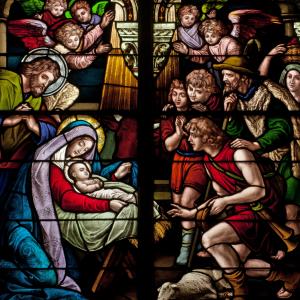
I CONFESS THAT I do not often use the Revised Common Lectionary. As a Bible professor, I prefer to read texts in their larger literary and historical contexts. When a brief reading from one time period is lifted out of its context and juxtaposed with another written many centuries later, it can feel like an invisible hand is forcing me to compare apples and oranges—or even apples and mushrooms.
Nevertheless, I have been enriched by this year’s readings for Advent and Christmas. My “larger historical context” has become the sweep of a thousand years of Israelite history, from King David to the birth of the “son of David.”
For Christians, the coming of Jesus was a singularity. Though we focus on his birth in this season, that lower-class event was barely noticed at the time, and it is not mentioned by two of our gospel writers. It is his entire life, ministry, death, and resurrection that echoes throughout the ages and ushers in our hope of salvation. Our prophets and psalmists from the Hebrew Bible could not foresee details of the Christ-event from their perspectives centuries earlier. Yet their intuitions and hints and poetic expressions of joy over God’s in-breaking from their times are now borrowed to give voice to our exultation over Jesus’ coming today.
In a culture measured by quarterly profits and immediate gratification by credit card, we need a longer view to better understand what God is doing throughout human history. These Advent readings call us beyond the present to the millennia of the past and the hope of the future stretching to eternity.
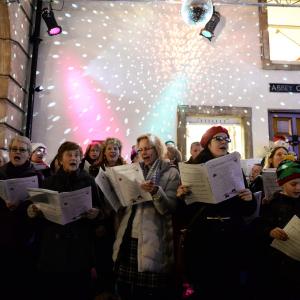
Reflections on the Revised Common Lectionary, Cycle C

A CLOTHESLINE IS AN ODD IMAGE for Advent spirituality, but it dances before my eyes, reminding me of the pleasure I had as a child helping my grandmother hang out our clothes to dry in the back garden. How fresh they smelled when we took them down! Those who have to use dryers may never know what they are missing.
After Christmas, we will be reading from Colossians about the new styles of being human that the Incarnation attracts us to try out for ourselves. After stripping ourselves to put on the baptismal self, each layer of our new outfit is “pegged out” on the line for us to admire and try on. “As God’s chosen ones, holy and beloved, clothe yourselves with compassion, kindness, humility, meekness, and patience ... Above all clothe yourselves with love, which binds everything together in perfect harmony” (3:12, 14). This same passage goes on to invite us to take seriously that meditation on scripture is a foundational Christian practice, not an optional one. Each of us must find our way of internalizing scripture, celebrating and investigating it in the inner space and landscape of our unique selves. “Let the word of Christ dwell in you richly” (3:16). Advent is a visitation to us of “words of Christ” that we need to invite in and entertain. Words of Christ as the coming Human One, our New Self, the indwelling Presence with which we are pregnant, the young Christ growing into God’s call.